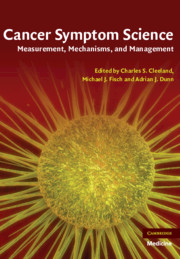Book contents
- Frontmatter
- Contents
- Contributors
- Foreword
- Credits and acknowledgements
- Section 1 Introduction
- Section 2 Cancer Symptom Mechanisms and Models: Clinical and Basic Science
- 4 The clinical science of cancer pain assessment and management
- 5 Pain: basic science
- 5a Mechanisms of disease-related pain in cancer: insights from the study of bone tumors
- 5b The physiology of neuropathic pain
- 6 Cognitive dysfunction: is chemobrain real?
- 7 Cognitive impairment: basic science
- 8 Depression in cancer: pathophysiology at the mind-body interface
- 9 Depressive illness: basic science
- 9a Animal models of depressive illness and sickness behavior
- 9b From inflammation to sickness and depression: the cytokine connection
- 10 Cancer-related fatigue: clinical science
- 11 Developing translational animal models of cancer-related fatigue
- 12 Cancer anorexia/weight loss syndrome: clinical science
- 13 Appetite loss/cachexia: basic science
- 14 Sleep and its disorders: clinical science
- 15 Sleep and its disorders: basic science
- 16 Proteins and symptoms
- 17 Genetic approaches to treating and preventing symptoms in patients with cancer
- 18 Functional imaging of symptoms
- 19 High-dose therapy and posttransplantation symptom burden: striking a balance
- Section 3 Clinical Perspectives In Symptom Management and Research
- Section 4 Symptom Measurement
- Section 5 Government and Industry Perspectives
- Section 6 Conclusion
- Index
- Plate section
- References
10 - Cancer-related fatigue: clinical science
from Section 2 - Cancer Symptom Mechanisms and Models: Clinical and Basic Science
Published online by Cambridge University Press: 05 August 2011
- Frontmatter
- Contents
- Contributors
- Foreword
- Credits and acknowledgements
- Section 1 Introduction
- Section 2 Cancer Symptom Mechanisms and Models: Clinical and Basic Science
- 4 The clinical science of cancer pain assessment and management
- 5 Pain: basic science
- 5a Mechanisms of disease-related pain in cancer: insights from the study of bone tumors
- 5b The physiology of neuropathic pain
- 6 Cognitive dysfunction: is chemobrain real?
- 7 Cognitive impairment: basic science
- 8 Depression in cancer: pathophysiology at the mind-body interface
- 9 Depressive illness: basic science
- 9a Animal models of depressive illness and sickness behavior
- 9b From inflammation to sickness and depression: the cytokine connection
- 10 Cancer-related fatigue: clinical science
- 11 Developing translational animal models of cancer-related fatigue
- 12 Cancer anorexia/weight loss syndrome: clinical science
- 13 Appetite loss/cachexia: basic science
- 14 Sleep and its disorders: clinical science
- 15 Sleep and its disorders: basic science
- 16 Proteins and symptoms
- 17 Genetic approaches to treating and preventing symptoms in patients with cancer
- 18 Functional imaging of symptoms
- 19 High-dose therapy and posttransplantation symptom burden: striking a balance
- Section 3 Clinical Perspectives In Symptom Management and Research
- Section 4 Symptom Measurement
- Section 5 Government and Industry Perspectives
- Section 6 Conclusion
- Index
- Plate section
- References
Summary
Fatigue is one of the most common, yet complex, symptoms reported by cancer patients and survivors. When fatigue is severe, it can be disabling. Because of ongoing debate about the definition of fatigue, inconclusive evidence about underlying pathophysiological mechanisms, and lack of effective pharmacological therapies, fatigue is a controversial and challenging subject for both researchers and those who manage patient care.
In this chapter, we introduce current understanding of cancer-related fatigue (CRF) and research on the mechanisms underlying CRF, discuss methodological issues for measuring CRF and then interpreting fatigue assessment results, and review innovations in CRF intervention.
Why address cancer-related fatigue?
The high prevalence and significant burden of fatigue in patients with cancer indicate the importance of understanding and managing it. The various methods used to measure fatigue in population-based studies have shown it to be the most common symptom that patients with cancer experience. In one study, outpatients with a variety of cancers treated in a tertiary-care cancer center reported that “severe fatigue,” “feeling weak,” and “not getting things done” were the most severe of the 26 symptoms included in the study. The percentage of patients with severe fatigue (fatigue rated 7 or higher on a 0–10 scale) is significantly greater than the percentage of healthy individuals with fatigue (34% and 17%, respectively). In a study of outpatients with hematological malignancies, 50% of the respondents reported having severe fatigue. Persistent cancer-related fatigue may be present among a subset of cancer survivors who have no evidence of active disease.
- Type
- Chapter
- Information
- Cancer Symptom ScienceMeasurement, Mechanisms, and Management, pp. 110 - 123Publisher: Cambridge University PressPrint publication year: 2010

